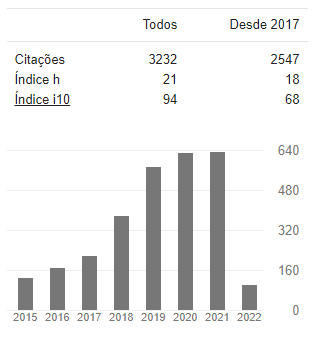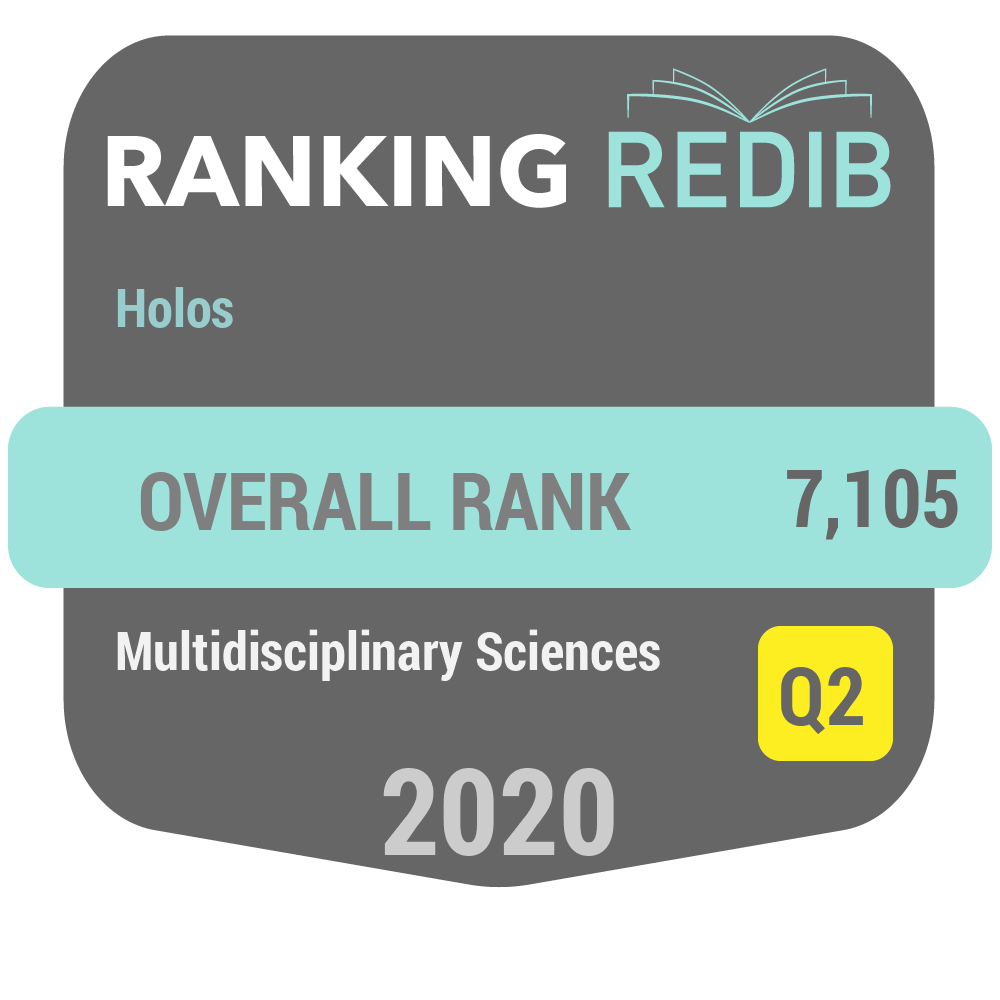STABILITY CONDITIONS EVALUATION OF SLOPE BY MULTIVARIATE ANALYSIS
DOI:
https://doi.org/10.15628/holos.2020.9036Palavras-chave:
Stability condition prediction, multivariate analysis, principal component analysis, discriminant analysis, non-parametric techniques.Resumo
Technological advances have contributed to applications of nonparametric methodologies with the objective of predicting slope stability conditions. The objective of this paper was to determine a discriminant function capable of predicting the stability condition of the slopes of the database under study. It is important to note that the methodology does not replace the stability analysis, but it can work very well for a preliminary analysis by selecting the slopes that must be intervened. The database used is composed by 59 slopes with relevant parameters in slope stability analysis with circular failure. A combination of multivariate statistical techniques, specifically principal component analysis (PCA) and discriminant analysis, was used to determine the slope stability condition. The principal component analysis was used to reduce the dimensionality of the database. The discriminant analysis was used to determine the boundary between stability conditions. Two types of discriminant function validations were performed, cross validation and external validation. The cross validation presented a global probability of success of 89.83%, the errors obtained in the cross validation were in favor of safety, with 5 stable slopes classified as unstable and only 1 unstable slope classified as stable. In the external validation were used 12 new slopes, which 8 slopes were correctly classified correctly.
Downloads
Referências
Bishop, A. W. (1955). The use of the slip circle in the stability analysis of slopes. Geotechnique, 5:7–17.
Cattell, R. B. (1966). The screen test for the number of factors. Multivariate Behavioral Research, 1:140-161
Fellenius, W. (1936). Calculation of the stability of earth dams. Transactions of the 2nd International Congress on Large Dams, Washington, USA, p. 445–462.
Feng, X. (2000). Introduction of Intelligent Rock Mechanics (p. 239-241). Beijing, China: Science Press.
Feng, X. Li, S. Yuan, C., Zeng, P., & Sun, Y. (2018). Prediction of Slope Stability using Naive Bayes Classifier. KSCE Journal of Civil Engineering, 22: 941-950.
Ferentinou, M. & Fakir, M. (2018). Integrating Rock Engineering Systems device and Artificial Neural Networks to predict stability conditions in an open pit. Engineering Geology, 246: 293-309.
Gordan, B. Jahed Armaghani, D. Hajihassani, M., & Monjezi, M. (2016). Prediction of seismic slope stability through combination of particle swarm optimization and neural network. Engineering with Computers, 32: 85-97.
Hoek, E. & Bray, J. W. (1981). Rock Slope Engineering (pp. 226-247, 3rd edition. London: Institution of Mining and Metallurgy).
Hoek, E., Read, J., Karzulovic, A., & Chen, Z. Y. (2000). Rock slopes in civil and mining engineering. GeoEng2000, Proceedings of the international conference on geotechnical & geological engineering, Melbourne, Australia.
Janbu, N. (1954). Application of composite slip surface for stability analysis. Proceedings of the European Conference on Stability of Earth Slopes, Stockholm, Sweden, p. 43–49.
Kaiser, H. F. (1958). The varimax criterion for analytic rotation in fator analysis. Psychometrika, 23: 187-200.
Li, X. & Kong, J. (2014). Application of GA-SVM method with parameter optimization for landslide development prediction. Natural Hazards and Earth System Sciences, 14:525-533.
Lin, P. S., Lin, M. H., Su, M. B., & Lee, T. M. (1988). An investigation on the failure of a building constructed on hillslope. Proceedings of 2nd International Symposium on Field Measurements in Geomechanics, A A Balkema, Kobe, pp. 445-44.
Madzic, E. (1988). Stability of unstable final slope in deep open iron mine. Proceedings of 2nd International Symposium on Field Measurements in Geomechanics, A A Balkema, Kobe, pp. 455-458.
Morgenstern, N. R. & Price, V. E. (1965). The analysis of the stability of general slip surfaces. Geotechnique, 15: 79–93.
R Development Core Team (2006). R: a language and environment for statistical computing. R Foundation for Statistical Computing, Vienna. ISBN 3-900051-07-0. http://www.Rproject.org. Accessed 2016
Rukhaiyar, S., Alam, M., & Samadhiya, N. (2017). A PSO-ANN hybrid model for predicting factor of safety of slope. International Journal of Geotechnical Engineering, 12: 6, 556-566.
Sah, N. Sheorey, P., & Upadhyaya, L. (1994). Maximum likelihood estimation of slope stability. International Journal of Rock Mechanics and Mining Sciences & Geomechanics Abstracts, 31:47-53.
Santos, A. E. M., Lana, M. S., Cabral, I. E., Pereira, T. M., Zare Naghadehi, M. , Silva, D. F. S., & Santos, T. B. (2018). Evaluation of rock slope stability conditions through discriminant analysis. Geotechnical and Geological Engineering. 37:1-28.
Silva, D. F. S., Santos, A. E. M., Ferreira, B. T., Pereira, T. M., & Corteletti, R. C. (2018). Cluster analysis for slope geotechnical prioritization of intervention for the Estrada de Ferro Vitória-Minas. REM, International Engineering Journal. 71:167-173.
Spencer, E. A. (1967). A method of analysis of the stability of embankments assuming parallel interslice forces. Geotechnique, 17:11–26.
Wang, H., Xu, W., & Xu, R. (2005). Slope stability evaluation using back propagation neural networks. Engineering Geology, 80: 302-315.
Xu, W., Xie, S., Jean-Pascal, D., Nicolas, B., & Imbert, P. (1999). Slope stability analysis and evaluation with probabilistic artificial neural network method. Investigation Science and Technology, 3: 19-21.
Xue, X. (2017). Prediction of slope stability based on Hybrid PSO and LSSVM. Journal of Computing in Civil Engineering, 31 : 1-10.
Yan, X. & Li, X. (2011). Bayes discriminant analysis method for predicting the stability of open pit slope. Proceedings of the International Conference on Electric Technology and Civil Engineering (ICETCE), Lushan, China, pp. 147-150.
Zare Naghadehi M., Jimenez R., Khalokakaie R., & Jalali S. M. E. (2013). A new open-pit mine slope instability index defined using the improved rock engineering systems approach. International Journal of Rock Mechanics and Mining Sciences, 61:1–14.
Zhou, K. & Chen, Z. (2009). Stability prediction of tailing dam slope based on neural network pattern recognition. Proceedings of Second International Conference on Environmental and Computer Science (ICECS'09),IEEE, Dubai, the United Arab Emirates, p. 380-383.









































